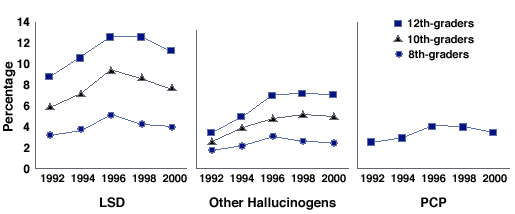

Psilocybin mushrooms and peyote cactus are plants that people have used to produce "visions." |
What are hallucinogens?
Hallucinogens are drugs that cause hallucinations - profound distortions in a person's perceptions of reality. Under the influence of hallucinogens, people see images, hear sounds, and feel sensations that seem real but do not exist. Some hallucinogens also produce rapid, intense emotional swings.
Hallucinogens cause their effects by disrupting the interaction of nerve cells and the neurotransmitter serotonin. Distributed throughout the brain and spinal cord, the serotonin system is involved in the control of behavioral, perceptual, and regulatory systems, including mood, hunger, body temperature, sexual behavior, muscle control, and sensory perception.
LSD (an abbreviation of the German words for "lysergic acid diethylamide") is the drug most commonly identified with the term "hallucinogen" and the most widely used in this class of drugs. It is considered the typical hallucinogen, and the characteristics of its action and effects described in this Research Report apply to the other hallucinogens, including mescaline, psilocybin, and ibogaine.
What are dissociative drugs?
Drugs such as PCP (phencyclidine) and ketamine, which were initially developed as general anesthetics for surgery, distort perceptions of sight and sound and produce feelings of detachment - dissociation - from the environment and self. But these mind-altering effects are not hallucinations. PCP and ketamine are therefore more properly known as "dissociative anesthetics." Dextromethorphan, a widely available cough suppressant, when taken in high doses can produce effects similar to those of PCP and ketamine.
The dissociative drugs act by altering distribution of the neurotransmitter glutamate throughout the brain. Glutamate is involved in perception of pain, responses to the environment, and memory. PCP is considered the typical dissociative drug, and the description of PCP's actions and effects in this Research Report largely applies to ketamine and dextromethorphan as well.
|

Source: Monitoring the Future Survey, 2000
Note: Data not available for PCP Prevalence for 8th and 10th graders. |
|